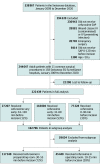Timing of Cefuroxime Surgical Antimicrobial Prophylaxis and Its Association With Surgical Site Infections
- PMID: 37289455
- PMCID: PMC10251212
- DOI: 10.1001/jamanetworkopen.2023.17370
Timing of Cefuroxime Surgical Antimicrobial Prophylaxis and Its Association With Surgical Site Infections
Abstract
Importance: World Health Organization guidelines recommend administering surgical antimicrobial prophylaxis (SAP), including cefuroxime, within 120 minutes prior to incision. However, data from clinical settings supporting this long interval is limited.
Objective: To assess whether earlier vs later timing of administration of cefuroxime SAP is associated with the occurrence of surgical site infections (SSI).
Design, setting, and participants: This cohort study included adult patients who underwent 1 of 11 major surgical procedures with cefuroxime SAP, documented by the Swissnoso SSI surveillance system between January 2009 and December 2020 at 158 Swiss hospitals. Data were analyzed from January 2021 to April 2023.
Exposures: Timing of cefuroxime SAP administration before incision was divided into 3 groups: 61 to 120 minutes before incision, 31 to 60 minutes before incision, and 0 to 30 minutes before incision. In addition, a subgroup analysis was performed with time windows of 30 to 55 minutes and 10 to 25 minutes as a surrogate marker for administration in the preoperating room vs in the operating room, respectively. The timing of SAP administration was defined as the start of the infusion obtained from the anesthesia protocol.
Main outcomes and measures: Occurrence of SSI according to Centers for Disease Control and Prevention definitions. Mixed-effects logistic regression models adjusted for institutional, patient, and perioperative variables were applied.
Results: Of 538 967 surveilled patients, 222 439 (104 047 men [46.8%]; median [IQR] age, 65.7 [53.9-74.2] years), fulfilled inclusion criteria. SSI was identified in 5355 patients (2.4%). Cefuroxime SAP was administered 61 to 120 minutes prior to incision in 27 207 patients (12.2%), 31 to 60 minutes prior to incision in 118 004 patients (53.1%), and 0 to 30 minutes prior to incision in 77 228 patients (34.7%). SAP administration at 0 to 30 minutes was significantly associated with a lower SSI rate (adjusted odds ratio [aOR], 0.85; 95% CI, 0.78-0.93; P < .001), as was SAP administration 31 to 60 minutes prior to incision (aOR, 0.91; 95% CI, 0.84-0.98; P = .01) compared with administration 61 to 120 minutes prior to incision. Administration 10 to 25 minutes prior to incision in 45 448 patients (20.4%) was significantly associated with a lower SSI rate (aOR, 0.89; 95% CI, 0.82-0.97; P = .009) vs administration within 30 to 55 minutes prior to incision in 117 348 patients (52.8%).
Conclusions and relevance: In this cohort study, administration of cefuroxime SAP closer to the incision time was associated with significantly lower odds of SSI, suggesting that cefuroxime SAP should be administrated within 60 minutes prior to incision, and ideally within 10 to 25 minutes.
Conflict of interest statement
Figures


References
-
- Magill SS, Edwards JR, Bamberg W, et al. ; Emerging Infections Program Healthcare-Associated Infections and Antimicrobial Use Prevalence Survey Team . Multistate point-prevalence survey of health care-associated infections. N Engl J Med. 2014;370(13):1198-1208. doi:10.1056/NEJMoa1306801 - DOI - PMC - PubMed
-
- Suetens C, Latour K, Kärki T, et al. ; Healthcare-Associated Infections Prevalence Study Group . Prevalence of healthcare-associated infections, estimated incidence and composite antimicrobial resistance index in acute care hospitals and long-term care facilities: results from two European point prevalence surveys, 2016 to 2017. Euro Surveill. 2018;23(46):1800516. doi:10.2807/1560-7917.ES.2018.23.46.1800516 - DOI - PMC - PubMed
-
- Allegranzi B, Zayed B, Bischoff P, et al. ; WHO Guidelines Development Group . New WHO recommendations on intraoperative and postoperative measures for surgical site infection prevention: an evidence-based global perspective. Lancet Infect Dis. 2016;16(12):e288-e303. doi:10.1016/S1473-3099(16)30402-9 - DOI - PubMed

